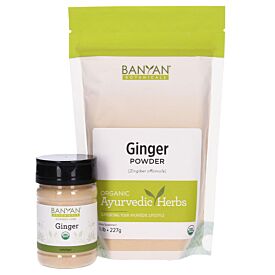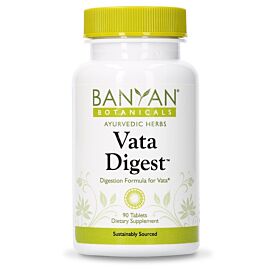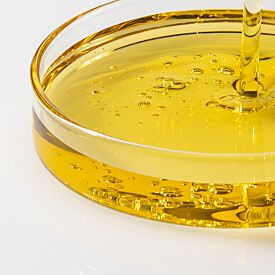How To Do a Ginger Compress for Your Kidneys & Adrenals
When I think of vata season, I think of ginger. I add it to almost all of my tea blends, my warm milk in the evening, and use it as a simple lime/salt/ginger digestive before meals. Ginger can also be used externally. Making a warm ginger compress is a unique self-care ritual I like to do on those especially chilly early fall evenings.
Sveda means to sweat, and svedhana is the Ayurvedic therapy that uses the application of heat, often as steam, to induce sweating. Heat invites the bodily channels to open, and svedana is an important part of the cleansing process because in order for toxins to flow out, the channels must first be opened.
Svedana therapies, which are of course hot or warm, are usually used to balance the cold quality of the vata and kapha doshas. Late summer to early winter is the perfect time of year for gentle svedana, as vata dosha is prominent at this time and the inherent quality of coldness and dryness can cause constriction in the tissues and channels.
Adrenal Glands and Ayurveda
The kidneys are an important part of the water channel of the body, the ambu vaha srotas. So warming the kidneys gently may help the body detoxify, allow for better flow in this channel, and support healthy kidney function. The adrenal glands are two small organs which sit on top of our kidneys. We hear about “adrenal fatigue,” which implies a sort of burnout. The adrenal glands are endocrine organs, meaning they help release and regulate our hormones—most notably cortisol and adrenaline. These are known as the “stress hormones.” When our body perceives us to be in a stressful situation, the adrenals pump out cortisol, keeping us in high-alert and high-energy mode. Tiredness and fatigue are often signs of burnout, as well as food cravings, changes in blood pressure, trouble sleeping, and low libido. (These can also indicate other complicated imbalances, and are listed here as examples.)
These symptoms are often signs of vata dosha imbalance. The warm, liquid, and soothing properties of this practice invite warmth and flow, which encourages homeostasis and healing.

How To Do A Ginger Compress
Sipping ginger tea can cause gentle sweating as the body warms up. In the case of a ginger compress, the aromatic tea is used externally to bring warmth and lubrication to the kidneys and adrenals glands.
A ginger compress should be done after a partial or full body self-massage (abhyanga) and on an empty stomach. When finished, wait a while to eat. This therapy is best done between 4 and 5 p.m. (vata time) or 7 and 8 p.m. (kapha time).
It can be a bit tricky to reach this area of your body yourself. If you have a willing friend or partner, ask for help (perhaps in exchange for a trade).
The instructions are as follows:
- Make a large pot of ginger tea, using about one handful of chopped, fresh ginger to a gallon of water. If you want, you can put the ginger in a cotton pouch or a large tea ball to keep it contained. Place the ginger in a covered pot, bring the water to a boil, and simmer for thirty minutes on low.
- While the tea is brewing, set up your treatment area. You will be lying on your stomach and can use something like a yoga mat with a few towels or blankets on top of it. Make sure you use towels/blankets that you do not mind getting a bit wet (ginger tea will not stain) or a bit oily (from the self-massage). Have a small or medium sized hand towel ready for the compress, and a dry towel nearby for post-treatment. Make sure you have a place to safely set the hot pot of tea. You may also want to have pillows nearby to help you feel comfortable when lying on your stomach. You can create a soothing environment by lighting candles, playing soft music, or using aromatherapy in the room.
- When the tea is ready, use oven mitts to carefully remove the pot from the heat. Place the covered pot in the spot you have prepared for it in your treatment area, and let it cool for at least five minutes.
- Do your self-massage, or abhyanga, as the tea cools. You may choose to only remove your shirt and massage the upper body, making sure you cover the kidney area in the center of your back body.
- Carefully uncover the pot of tea. Hold both ends of your hand towel and dip the middle of it into the tea, letting it sit in the liquid for a few moments. Gently lift it out of the water and twist the ends of the towel to squeeze some of the water/tea out of the middle. It will be quite hot, so be careful not to burn yourself. Let the towel unroll and shake it out very gently over the pot to release some of the heat. It should be damp but not sopping.
- With care, test the heat of the towel on your hand or arm (you may be surprised at how sensitive your back can be). When you feel ready, lie down on your belly on your mat, and folding the damp towel once, place it over your kidney area. You may want to use one hand to add some pressure to the towel for a moment. The heat should feel nice.
- Rest for a few minutes, relaxing into the heat of the towel.
- When the towel starts to cool, re-heat it and repeat the process. Do this for a maximum of thirty minutes.
- When finished, you may choose continue with a full body self-massage if you have only done a partial one, hop into a warm shower, or simply head to bed.












